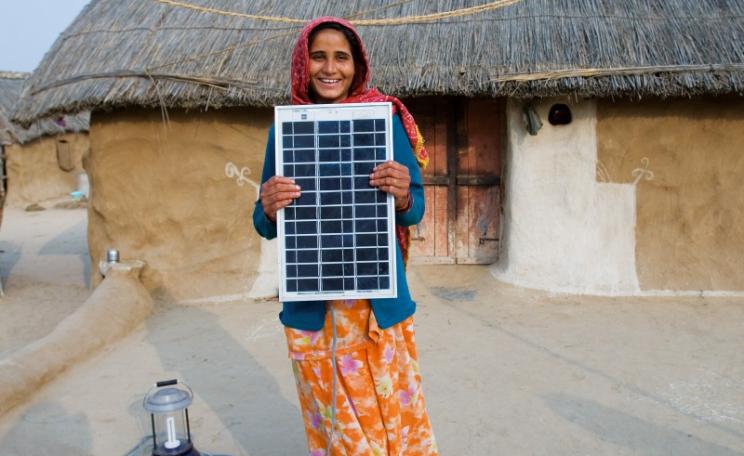When the accountants have fully loaded the network and other costs PV ends up as very slightly cheaper than using lndian-mined coal. And, of course, this advantage will grow as solar gets cheaper.
Commentators eager to arrest the move towards renewable energy are facing increasing difficulties finding arguments for the continued use of fossil fuel.
The latest attempt to justify the use of carbon fuels is that 'otherwise people in poorer countries will never get electricity'. Coal is vital, they say, for the alleviation of the conditions of life in less developed countries.
I have recently finished a draft of a book chapter on the growth of solar around the world. The very unpolished extract below is largely based on an exceptional piece of work by KPMG India on the likely evolution of the costs of solar versus coal in that country.
I think their conclusion - essentially that solar is already competitive with coal even after including distribution charges and grid integration costs, and will become much cheaper in future - is an effective response to the 'coal alleviates poverty' meme.
Governments are increasingly using open auctions as the means by which they attract developers into building solar farms. Each participant offers an electricity price, expressed in cents per kilowatt hour, for power from individual locations. The past year (2015) has seen a sharp decline in the prices bid into these auctions everywhere around the world.
India: solar PV bids already under 5p / 7¢
India is a good example as it begins its drive to get electricity to all its huge population. In 2014 developers offered to build solar farms for payments of an average of about 7 rupees per kilowatt hour. That's around 10 US ¢, or 7 UK pence at current exchange rates. Three state auctions in the third quarter of 2015 in Madhya Pradesh, Telangana and Punjab saw offers of just over 5 rupees (5p / 7.5¢).
The Indian press openly speculated that these offers were too low to be profitable for their developers. But in November 2015 another round of tenders in Andhra Pradesh in south east India resulted in a low bid of 4.63 rupees (about 4.6p / 7¢ per kilowatt hour).
This was for sites totalling 500 MW and was won by the US company SunEdison, the world's largest renewable energy developer. It currently claims to be installing 4 gigawatts of capacity a year around the world. In the face of this evidence of expertise from the bidder, this time the scepticism about the viability of the price was more muted.
Just before the Andhra Pradesh auction was completed, accountants India KPMG released a detailed report on the state of PV in their country. "We see solar power becoming a mainstay of our energy landscape in the next decade", they wrote.
As we all tend to be, they were still cautious about future solar PV bids. KPMG'S best guess for auction prices was 4.20 rupees per kilowatt hour (about 4.2p / 6.3¢) by 2020, only about 10% more than the SunEdison November 2015 bid.
When the accountants have fully loaded the network and other costs PV ends up as very slightly cheaper than using lndian-mined coal. And, of course, this advantage will grow as solar gets cheaper.
Now it's cheaper than coal
What matters most in India is how well these numbers compare to electricity from inexpensive locally-mined coal. KPMG says that the current cost of power from this source is about 4.46 rupees (4.5p / 6.7¢) per kilowatt hour, about 4% below the November 2015 record low bid in Andhya Pradesh.
But in a power station using some imported coal, the accountants calculate, the cost would be higher than solar. In India, PV is now directly competitive with some coal power stations and by 2020 it will be 10% cheaper, KPMG conclude. They predict that the raw cost of solar electricity from big solar farms will be 3.5 to 3.7 rupees by 2025. (Around 3.6p / 5.5¢). If history is any guide, they are being pessimistic.
2014 bids
All ~7
Q3 2015
Punjab - 5.09
Telagana - 5.17
Madhya Pradesh - 5.05
November 2015
Andhra Pradesh - 4.63
For comparison
Electricity from Local coal - 4.46
Electricity at coastal coal plants using imported coal - INR 4.76
All figures are Indian rupees per kilowatt hour.
Low grid costs for local power use
These numbers are not complete. We also need to include the cost of getting the electricity to the final consumer. In many countries this penalises solar but not so in India, says KPMG. Many of the coal plants are hundreds of kilometres away from the centres of electricity demand so the relative attractiveness of solar is improved when electricity distribution costs ('network charges') are fully included.
In fact when the accountants have fully loaded the network and other costs PV ends up as very slightly cheaper than using lndian-mined coal. And, of course, this advantage will grow as solar gets cheaper.
You are entitled to respond by saying that PV only produces electricity, even in the sunniest parts of India for an average of 12 hours a day. When people want light to read, cook or study, it isn't available. (Solving this problem is what much of the rest of the book is about).
But what we may not have known is that almost 20% of all Indian electricity demand at the moment is used for pumping water for irrigation. This can easily be carried out solely in the daytime.
At the moment PV only provides a tiny fraction of Indian electricity. But it will grow rapidly with strong backing from the Modi government and from the favourable underlying economics. As in other countries around the world, it will then start to become increasingly costly to run the grid to cope with the unpredictability and diurnal variability of solar power.
More PV means more batteries to help stabilise the voltage of the grid, for example, in the event of unexpectedly high or low sunshine.
And, very sensibly, KPMG also includes a cost for the financial impact of coal fired power plants working fewer and fewer hours as solar soars. This is a real financial burden because running the fixed costs of these power stations will be spread across a smaller electricity output.
By 2025, what are the impacts of these charges, usually known as 'grid integration' costs, once PV has become a really significant portion of all electricity production? KPMG thinks the figure for India will be about 1.2 rupees (1.2p / 1.8¢) per kilowatt hour.
This is roughly in line with estimates for other countries. Even after including this figure, PV is still cheaper than coal in 2025 and then provides 12.5% of all Indian electricity from about 166 GW of installed capacity.
An unstoppable momentum
Most of the KPMG work is focused on the finances of building ground-mounted solar farms for large-scale production. But it also looks at two specific applications: driving agricultural pumping operations (a task often performed by highly polluting diesel generating sets at the moment) and, second, what the accountants call the 'Solar House'. What do they mean by this?
"The concept of the 'Solar House' refers to the condition when the entire power needs of a household can be met by rooftop and on-site solar panels, which combined with energy storage, can potentially make the household completely independent of the grid. This can happen when technology will bring the cost of solar power and storage systems to below the cost of power delivered by the grid. This event has the potential to change the dynamics of the power utility-customer relationship(s) forever."
They go on to get really excited about Solar Houses. When have you ever seen accountants write like this before?
"The achievement of the 'Solar House' is expected to be a landmark in mankind's efforts to access energy. The 'Solar House' will help India leapfrog technologies in the area of supplying uninterrupted 24x7 energy to its citizens. When the conditions for the 'Solar House' are achieved, (it) can override all barriers."
KPMG expects 20% of Indian houses to have PV by 2024/25. The authors make the point that once residential batteries have come down in price sufficiently, householders have a clear and unambiguous reason to switch to solar. It will be cheaper than being connected to what may be an unreliable and possibly expensive grid.
And, as we may be seeing in other countries already, once households drift away from being connected, or even if they simply use far less electricity because of the PV on their roofs, the costs of the distribution network need to be spread ever more thickly on those that remain. That further increases the incentive on those people remaining on the grid to switch to PV.'
Chris Goodall is an expert on energy, environment and climate change, and a frequent contributor to The Ecologist. He blogs at Carbon Commentary. His next book, 'The Switch', is due for publication in 2016.
This article was first published on Carbon Commentary. It is an extract from The Switch, a book about the global transition to solar power, to be published in June 2016 by Profile Books.







